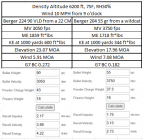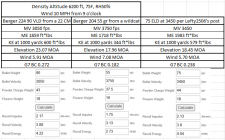Now is this combination the flattest cartridge at longer distances?
I agree with what Tommie is saying but will add my comment on the trajectory part of it.
Tommie isn't wrong, there are a few examples of a flatter trajectory, but coming up with one for prairie dog example isn't easy.
When we are out past 600 yards and willing to go to 1000, the 55 Berger doing 3750 fps is way up on the list of flattest trajectories compared to most cartridges and only surpassed by ones with a lot more recoil, cost per shot, and effort. Not the kinds of examples you would typically run on a small critter like a prairie dog, but at the same time there is nothing typical about popping prairie dogs out past 600 yards.
After all, the hit probability for a single uncorrected shot on an adult prairie dog at 1000 yards is not very high and it gets worse fast with any variability in wind.
Before I turn my sights on a mound at 1000 yards, I usually take my wind readings and test the wind call at say 600 or so. This gives me a pretty good idea of what else is going on due to unseen variations and terrain that affects the wind call to at least that shot, plus it warms up the gun.
If the gun has been "warmed up" in a similar direction and you have a chance to dope the winds, then the odds tend to shift towards the accuracy of the range call. If that warm-up shot is on the order of 600 yards and you have some experience with wind calls, you can shift out to 1000 yards with a much higher probability of an uncorrected hit since you narrowed down your wind tolerance.
So to Tommie's point... Are there other cartridges/bullets with a flatter trajectory, yes but most folks would be hard pressed to name them.
Real world bullets that are used for civilian sporting purposes are made of materials with densities we are all familiar with, namely lead based. Air being what it is, if you charted all the higher BC bullets you would find the 55 Berger is what we would call a "Corner Case". That means on a two axis performance chart that includes the bullet mass and the BC, there are not many production bullets that surpass it at the speeds we would call typical for the caliber.
I'll post a side-by-side of my 22CM with a Berger 90 VLD next to the wildcat using the Berger 55 to illustrate. You can see the 90 VLD has an amazing BC, and given a good load in a 22 CM you can send it at over 3000 fps. However, it still takes 28% more elevation (23.07/17.96) if we give both guns an equal 100 yard zero. To be fair, 22 CM arrives with more energy and requires less windage (5.91/7.08).
Let me know your favorite bullet/load. If your favorite bullet is in the Applied Ballistics database, just list out your details and I will be happy to crunch the numbers to see how they compare, time permitting... YMMV













